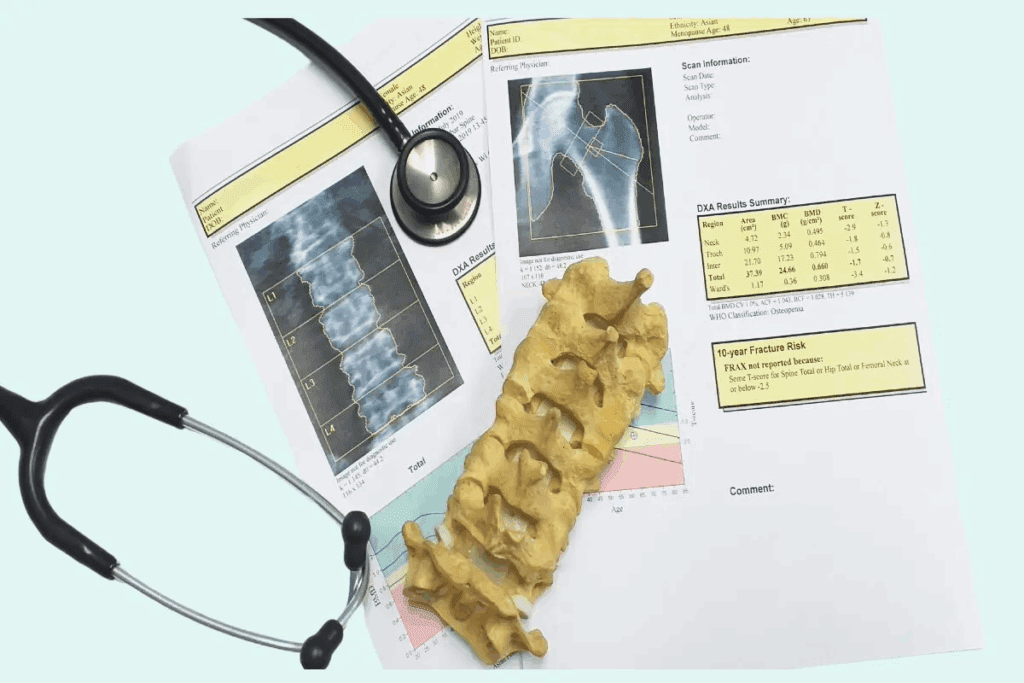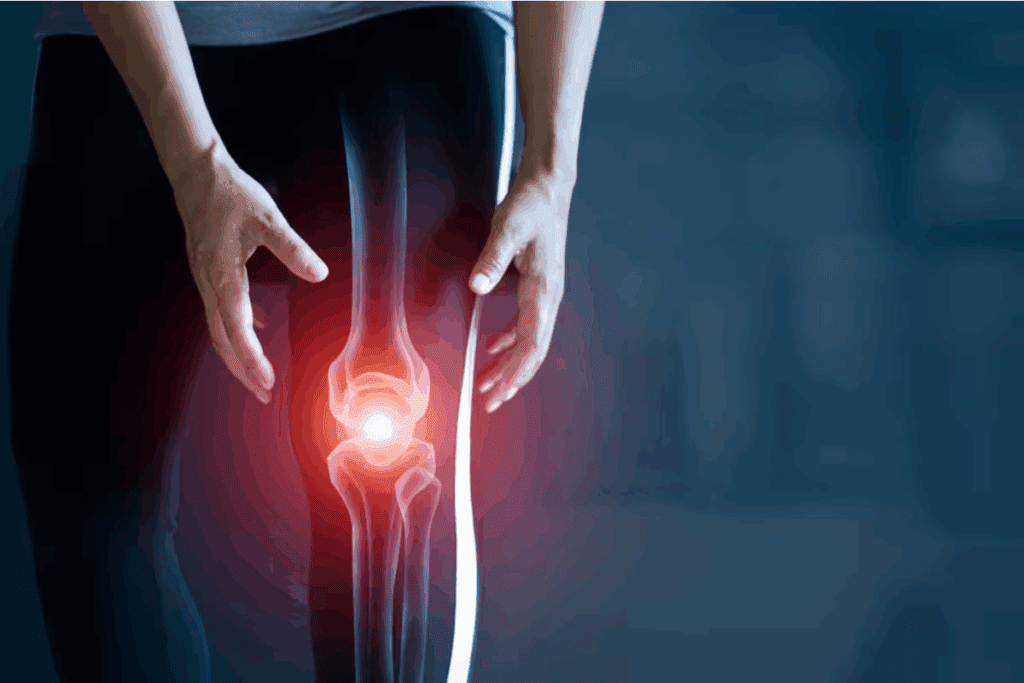Last Updated on November 14, 2025 by mcelik

Did you know over 10 million Americans have osteoporosis? This condition weakens bones and makes them break easier. Exercising regularly is key to managing it.
Finding the right exercise is important for strong bones and health. In this article, we’ll look at the best exercises for osteoporosis. We’ll also share tips on how to exercise safely.
Osteoporosis weakens bones, making them break easily. It’s common in older people and women after menopause. Exercise is key to managing it.
Bones get weak when the body can’t make new bone or when too much old bone is lost. This makes bones brittle and prone to fractures. Often, people don’t notice symptoms until they break a bone.

Bone density is how strong bones are. Osteoporosis lowers bone density, making bones weak. It affects both the spongy inside and the dense outside of bones.
Genetics, hormonal changes, and lifestyle can increase osteoporosis risk. Knowing these factors helps manage and prevent the condition.
Exercise is essential for osteoporosis management. It keeps or boosts bone density. Activities like weight-bearing and resistance exercises strengthen bones and muscles.
Understanding osteoporosis and exercising wisely can greatly improve life quality. It helps manage the condition and strengthens bones.
For those with osteoporosis, exercise is key. It helps keep bones strong and reduces fracture risk. It also makes life better overall.
Exercise is great for osteoporosis patients. It keeps bones dense, which stops fractures. It also boosts balance and posture, lowering fall risks.
The National Osteoporosis Society says balance and strength exercises are best. These include activities that make bones and muscles stronger.
Exercise makes bones grow through several ways. Weight-bearing activities, like walking, make bones work hard. This makes them denser.
Resistance training also helps bones get stronger. It puts stress on bones, making them adapt and grow.
Many studies have looked at exercise’s effect on bones in osteoporosis patients. They show that the right exercises can make bones stronger.
A study found that a special exercise program helped postmenopausal women with osteoporosis. It included weight-bearing and resistance exercises.
This research highlights the role of exercise in managing osteoporosis. It shows how important it is to stay active for better bone health.

Weight-bearing activities are key for people with osteoporosis. They help strengthen bones and improve density. These exercises make you move your body against gravity while staying upright.
Weight-bearing exercises require you to support your body’s weight against gravity. Examples include walking, dancing, hiking, and climbing stairs. They are important because they help grow bones and increase bone density.
Key benefits of weight-bearing exercises include:
Weight-bearing exercises can be high-impact or low-impact. High-impact activities like running or jumping are effective but might not be safe for everyone. Low-impact exercises, such as brisk walking, are safer but also beneficial.
The right amount of weight-bearing exercises varies by individual. Aim for three to four times a week, with each session lasting 30 to 45 minutes. Start slow and increase intensity and duration as you get stronger.
Here are some tips for the best results:
Resistance and strength training are key for managing osteoporosis and boosting bone density. The National Osteoporosis Society says exercise is vital for bone health. A good resistance strength training plan can greatly improve bone health and lower fracture risk.
Resistance training makes bones grow stronger by stressing them. This stress prompts bones to get denser and stronger. It’s very important for people with osteoporosis, as it helps fight bone loss.
A muscle strengthening program focusing on big muscle groups works best.
Bodyweight exercises are perfect for beginners. They use your own weight as resistance and can be adjusted for any fitness level. Squats, lunges, and push-ups are great because they work many muscles and help bones get stronger.
When you get better at bodyweight exercises, try progressive resistance training. This means adding more weight or resistance over time. It keeps muscles and bones challenged. A good progressive resistance training program can be made just for you, based on your needs and goals.
Adding resistance and strength training to your routine can help manage osteoporosis. It’s a way to actively improve your bone health.
Walking is a low-impact exercise that helps manage osteoporosis. It’s easy for most people to do, no matter their age or fitness level.
Walking regularly is good for bones. It keeps bones strong, improves balance, and lowers fall risks. Key benefits of walking for osteoporosis management include:
To get the most from walking, create a good walking program. Set achievable goals, pick safe routes, and slowly increase walk time and intensity.
Tips for creating a walking program:
Proper walking technique is key for safety and effectiveness. Keep good posture, wear right shoes, and stay alert.
Key elements of proper walking technique:
Stair climbing and light jogging are great for strengthening bones in people with osteoporosis. They help grow bones and boost bone density.
Stair climbing is a tough exercise that boosts bone density. It works many muscles and needs balance and coordination. This makes it a top choice for staying fit.
The National Osteoporosis Society says stair climbing is good for bones. It puts stress on bones, which helps keep them healthy.
Light jogging is also good for bones, but it depends on your health. Start slow and build up your jog as you get fitter.
Wear the right shoes and run right to avoid injuries. It’s key to start small and go slow.
Staying safe is important when doing high-impact activities like stair climbing and jogging. Make sure you’re fit and balanced before you start.
Always talk to a doctor or physical therapist before starting any exercise program. They can make sure it’s right for you.
Effective balance training routines can greatly lower the risk of falls in people with osteoporosis. Falls are a big worry for those with osteoporosis, as they can cause fractures. Adding balance exercises to your daily routine can make you more stable and lower fall risks.
Balance training is key to preventing falls and fractures. It helps people move better, avoid tripping, and stay independent. Studies show that balance exercises are important in managing osteoporosis to lower fracture risk.
Key benefits of balance training include:
Starting with simple balance exercises makes it easy to add them to your daily routine. Examples include:
As balance gets better, it’s important to make the training harder. This can be done by:
By adding these balance training routines to their lifestyle, people with osteoporosis can greatly reduce their fall risk. This improves their quality of life.
Hip strengthening workouts are key in managing osteoporosis. They help increase bone density and prevent fractures. The National Osteoporosis Society says exercises that strengthen the hips are vital for bone health.
Strong hip muscles help keep balance and prevent falls. Falls are a big cause of fractures in people with osteoporosis. Hip strength is linked to stability and mobility, making it a key area in managing osteoporosis.
Several exercises can strengthen the hips, including:
These exercises target hip muscles, improving strength and stability. Start with lower intensity and increase as fitness improves.
| Exercise | Starting Position | Action | Repetitions |
| Clamshell | Lie on your side with knees bent | Open your knees, keeping feet together | 10-15 |
| Side Leg Lifts | Lie on your side with legs straight | Lift the top leg towards the ceiling | 10-15 |
| Hip Bridges | Lie on your back with knees bent | Lift your hips towards the ceiling | 10-15 |
It’s important to adjust hip exercises based on fitness levels. Beginners can start with bodyweight exercises or resistance bands. As fitness grows, move to more challenging exercises or add weights.
For advanced fitness levels, try single-leg squats or step-ups. Always check with a healthcare provider or physical therapist to create a program that fits your needs and abilities.
For those with osteoporosis, good posture is more than looks. It’s about keeping bones strong. Correct posture lessens bone and muscle strain, which can lower fracture risk. This section will dive into the role of posture correction and spinal extension exercises in managing osteoporosis.
Good posture keeps the spine’s natural curves intact. When posture is right, the spine bears less stress, lowering fracture risk.
Benefits of Good Posture:
Several exercises can boost back muscles and posture. These include:
Spinal extension exercises are key for vertebrae strength and posture. Examples include:
The following table summarizes key exercises for posture correction and spinal extension:
| Exercise | Purpose | Repetitions |
| Chest Stretch | Improve flexibility | 3 sets of 30 seconds |
| Shoulder Blade Squeeze | Strengthen upper back | 3 sets of 10 reps |
| Prone Back Extension | Strengthen vertebrae | 3 sets of 5 reps |
For those with osteoporosis, yoga and stretching can greatly help. They improve flexibility and bone health. The National Osteoporosis Society says exercise is key to keeping bones strong and preventing fractures.
Yoga combines poses, breathing, and meditation for well-being. It’s great for people with osteoporosis when done right.
Some yoga poses are great for osteoporosis. Here are a few:
These poses can boost flexibility, balance, and strength. They’re key for managing osteoporosis.
Adding safe stretches to your day can improve joint mobility. It also lowers injury risk. Here are some good stretches:
Do these stretches gently and within a safe range to avoid injury.
Some yoga poses need to be changed for osteoporosis. For example:
Changing poses makes practice safer and more beneficial. Always practice with a qualified yoga teacher who knows about osteoporosis.
Yoga and stretching can make you more flexible, balanced, and healthy. They help you live a more active and healthy life.
Core strengthening is key in managing osteoporosis. Pilates is a great way to do this. It focuses on controlled movements to strengthen the core muscles. This improves spinal stability and bone health.
Pilates is great for those with osteoporosis. It promotes functional movement training. This helps the body move safely and do daily tasks better.
It strengthens the core muscles. These muscles are important for good posture and preventing falls. Pilates is low-impact, which is good for those with osteoporosis. It reduces the chance of injury.
Plus, Pilates can be changed to fit different fitness levels. This makes it available to many people.
Core exercises are central to Pilates. They aim to improve trunk stability and support the spine. Some effective exercises include:
Doing these exercises right and often can greatly improve core strength. It also lowers the risk of osteoporotic fractures.
For those with osteoporosis, it’s important to adjust Pilates exercises. Avoid movements that could strain the bones too much, like deep bends or twists.
Having a qualified Pilates instructor who knows about osteoporosis is key. They can make exercises safe and effective for you. They’ll adjust them to fit your needs and abilities.
Managing osteoporosis requires teamwork with healthcare professionals. Together, they create a personalized exercise plan. This plan is safe and effective, considering the person’s health and limitations.
Before starting any new exercise, those with osteoporosis need medical clearance. This is key to avoid health risks and discuss any needed changes.
Medical clearance involves a detailed health check. It looks at the person’s medical history, current health, and medications.
Physical therapists and exercise specialists are vital in creating a custom exercise plan. They teach proper techniques, adjust exercises for physical limitations, and track progress.
For example, tai chi practice can help with balance and fall prevention. They help individuals learn tai chi at their own pace.
| Benefits of Collaboration | Description |
| Personalized Exercise Plans | Tailored to the individual’s health status and fitness level |
| Improved Safety | Reduced risk of injury through proper technique and modifications |
| Enhanced Effectiveness | Better outcomes through targeted exercises and progressive overload |
It’s important to regularly check how well the exercise program is working. Healthcare providers and exercise specialists can adjust the plan as needed. This ensures the best results.
An exercise program for osteoporosis should change over time. It adapts to the person’s progress, health changes, and new needs.
Some exercises can harm people with osteoporosis, leading to fractures. It’s key to know which activities to skip and how to change your workout to keep bones strong.
Exercises that put too much stress on bones are bad for those with osteoporosis. High-risk movements include:
These activities can raise the chance of fractures, mainly in the spine, hips, and wrists. Knowing these risks and changing your workout is vital.
There are safer options to common exercises that help keep bones strong without the risk of fractures. For instance:
| High-Risk Exercise | Safer Alternative |
| Deep squats | Bodyweight squats or chair squats |
| Forward bending exercises | Spinal extension exercises or gentle stretching |
| High-impact aerobics | Brisk walking, swimming, or cycling |
These alternatives help keep bones healthy while lowering injury risk.
People with osteoporosis might face physical challenges like mobility issues or chronic pain. It’s important to:
By adapting to physical limitations and adjusting workouts, those with osteoporosis can keep bones healthy and lower fracture risk.
Managing osteoporosis well means using a full approach, including a good exercise plan. Activities like weight-bearing, resistance training, and balance exercises help. They make bones stronger and lower the chance of breaking them.
Creating a personal exercise plan with a healthcare team is key. It helps keep bones healthy and boosts overall health. Exercise also improves balance and posture. This makes it less likely to fall and get hurt.
Being active and managing osteoporosis is a way to control bone health. It helps keep you active and independent for a long time.
The top exercises for osteoporosis include activities that make your bones stronger. These are weight-bearing, resistance training, and balance exercises. Examples are walking, stair climbing, and light jogging. Also, bodyweight exercises and yoga poses are good.
You should exercise often, aiming for 3-4 times a week. Mix weight-bearing, resistance, and balance exercises. But, adjust the frequency and intensity based on your fitness and health.
High-impact exercises might be too risky for those with osteoporosis, if they’ve had fractures before. Start with low-impact activities and slowly move to more intense ones. Always get your doctor’s okay first.
Yes, yoga can help manage osteoporosis. It improves flexibility, balance, and strength. Poses like tree pose and warrior pose can strengthen bones and improve posture. But, avoid poses that might strain your bones too much.
To improve balance, try specific exercises like standing on one foot and heel-to-toe walking. Tai chi is also great. These can make you more stable and lower your fall risk.
Good hip exercises for osteoporosis include squats, lunges, and leg press. These strengthen the hips, which helps prevent fractures and keeps you mobile.
Yes, Pilates can help manage osteoporosis. It strengthens the core, improves posture, and boosts physical function. You can modify Pilates to fit your needs and bone health.
Yes, avoid exercises that could lead to fractures, like bending, twisting, or heavy lifting. Also, stay away from exercises with heavy impact or jarring movements.
To create a safe exercise plan, talk to your healthcare provider. They can give you medical clearance and suggest exercises that fit your needs. Working with physical therapists or exercise specialists can also help make a personalized plan.
Subscribe to our e-newsletter to stay informed about the latest innovations in the world of health and exclusive offers!